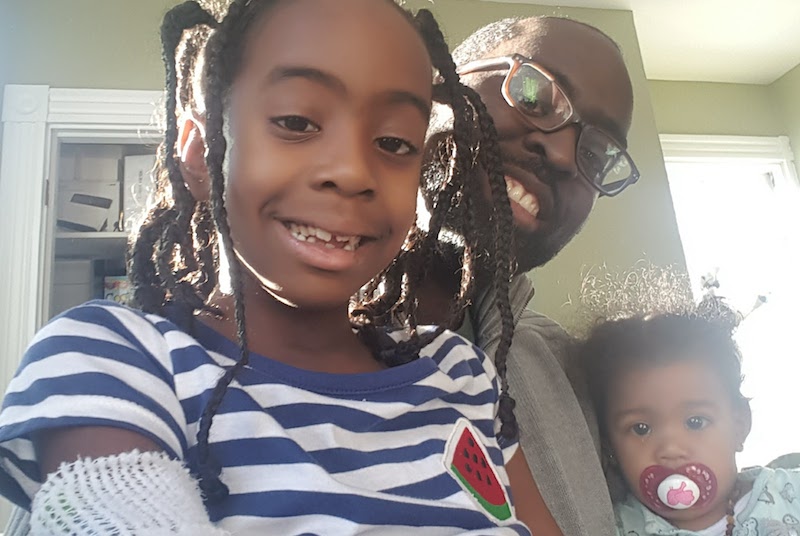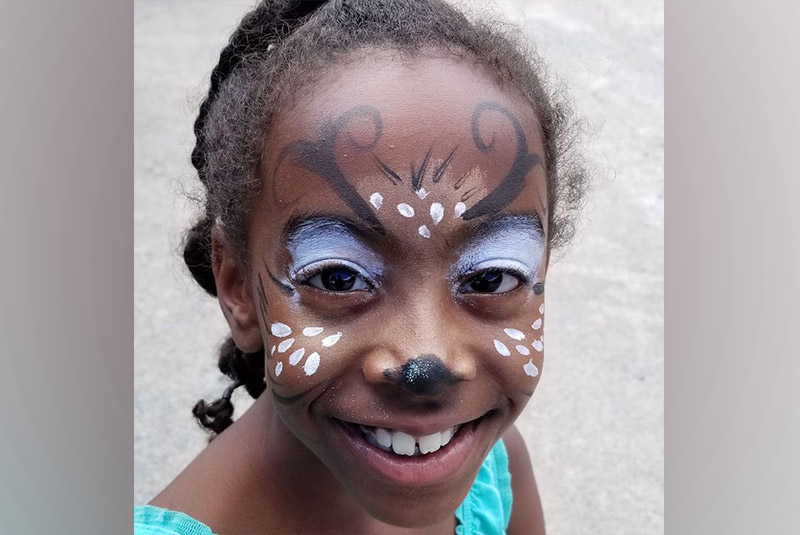Jasmine and the puffy tumor: A diagnosis in the nick of time

The Dominique family had just returned from a wonderful trip to Disney World in 2017 when 7-year-old Jasmine came down with a sinus infection. She was in a lot of pain, so her parents took her to their local urgent care center.
“They prescribed antibiotics, but even after a week they didn’t seem to be working,” says her dad, Prisnel. “She wasn’t getting better and her pain was increasing.” They took Jasmine to her primary care physician (PCP), who examined her and prescribed a different antibiotic.
A troubling symptom leads to a referral and diagnosis
The next day, Jasmine’s mom, Janelle, who happens to be a nurse, noticed a troubling symptom: Jasmine’s forehead seemed to be protruding slightly. She called the Emergency Department at Boston Children’s Hospital and was told to bring her in.

“As soon as we arrived they got her into a room quickly and a doctor came in to do an exam,” says Prisnel. “After a minute he said, ‘I think I know what this is — let me go check one thing,’ and within a half hour we had a diagnosis of Pott’s puffy tumor.”
A tumor that’s not really a tumor
Like many people, the Dominiques had never heard of this rare condition. A Pott’s puffy tumor isn’t really a tumor at all, but a mass of infectious fluid that collects in the forehead, often as the result of a sinus infection or head trauma. If not treated, the fluid can cause an infection in the frontal bone of the head and be fatal. Although anyone can develop a puffy tumor, it’s most common in teens.
After running more tests on Jasmine to confirm the diagnosis, neurosurgeon Dr. Benjamin Warf told the Dominiques that Jasmine would need emergency surgery to drain the tumor.
“Dr. Warf explained they usually have to make a cut right across the forehead and into the plate in the head, and I became very emotional thinking about my daughter having that type of surgery,” says Prisnel. “But then he told us that he wanted to be as non-invasive as possible, so instead he planned to drill into one area of the bone and then use scopes to drain the tumor.”

Once they had settled on a surgical plan, it was time to tell Jasmine about the surgery. Still feeling emotional and overwhelmed by the news, neither Prisnel nor Janelle could bring themselves to explain it to her. “We just didn’t have the words,” he says.
Explaining surgery with a unicorn
Dr. Warf suggested they have a child life specialist come in to talk with Jasmine. “She was amazing — she got right down on my daughter’s level and started asking her about the stuffed animals on her bed,” says Prisnel. When Jasmine mentioned her love of unicorns, the child life specialist saw an opening and explained that Jasmine had some gunky stuff in her head and that she had to have a procedure to remove it — and afterwards, she would look like unicorn without its horn for a little while. “To our amazement, Jasmine was totally fine with it all. The child life specialist really knew how to explain what was going on so Jasmine could understand and not be afraid.”
After the two-hour surgery, Jasmine remained in the hospital for another week, as she needed to be on a heavy dose of IV antibiotics to fight the infection. “She was tracked by both neurosurgery and infectious disease, and I was really impressed with the whole experience and the rounds that I sat in on,” says Prisnel. “It was truly a positive experience.”

Jasmine was sent home with an IV line for the antibiotics she needed. “Boston Children’s helped us with that as well,” says Prisnel. “They set up a nurse to come in every other day for two weeks to help us make sure we were changing the line correctly.”
Three months later, Jasmine went in for a follow-up visit and CT scan and was given a clean bill of health. She doesn’t need any further follow-up care.
Joining the FAC family
Prisnel was so moved by the experience that he decided to join the Boston Children’s Family Advisory Council (FAC). “I wanted to give back, not just for saving her life, but also for giving her such a quality experience throughout.” He says that because Jasmine doesn’t have a chronic condition for which she needs ongoing care, he brings a slightly different perspective to the table that the other FAC members appreciate.

“We were so grateful that the doctors at Boston Children’s caught this before it was too late, and when it was missed by other reputable doctors,” says Prisnel. “The entire experience at Boston Children’s was just so positive and we received such compassionate care, it really made a big impression on us.”
Learn more about the Department of Neurosurgery.
Related Posts :
-

What orthopedic trauma surgeons wish more parents knew about lawnmower injuries
Summer is full of delights: lemonade, ice cream, and fresh-cut grass to name a few. Unfortunately, the warmer months can ...
-

A fall from a swing uncovers a rare cervical spine condition: Charlotte’s story
If it were any other year, Charlotte Gillis would have celebrated her 10th birthday in mid-July with a big party. ...
-

MRI could reduce the mystery of brachial plexus injuries in infants
About one in 1,000 children are born with brachial plexus birth injury (BPBI), upper extremity weakness or paralysis resulting from trauma ...
-

For Fiadh: Pushing the envelope to treat drug-resistant epilepsy
Fiadh is a bubbly and empathetic 4-year-old. And if you ask her parents, Elaine and Dario, she’s also mischievous ...





